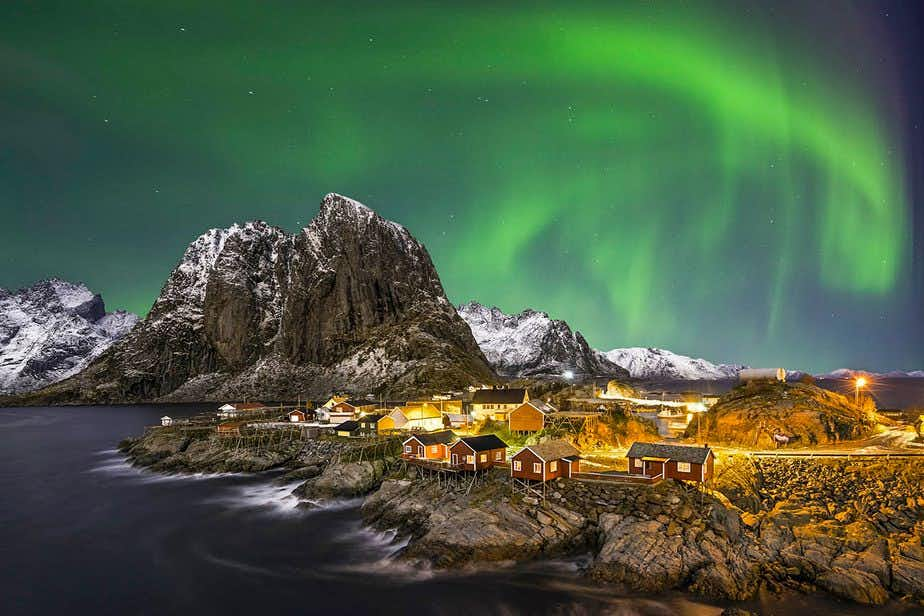Login
No account yet?
Create Account
Best locations for Northern Lights
The north of Norway is one of the best places to see this natural phenomenon
8 travellers have this on their Bucket List
0 been here
The Northern Lights are fairly common in Norway. Anyone who has seen the Northern Lights will confirm. It is one of the most beautiful natural phenomenon that you should have seen in your life.
Curtains of light dancing in the sky, in various colours. That are the Northern Lights. You must see it to believe it. According to experts, northern Norway is the best place to watch this spectacular phenomenon.
5 best locations for the Northern Lights in Norway
You can see this graceful show by Mother Nature just about anywhere in Norway. But the northern part of the country is best. You'll have the lights directly above you, so it can be easily seen. These are the best places where the Northern Lights can be seen remarkably often every year.
Tromsø
This city and its surroundings are considered the best. This coastal city has the most Northern Light Days of all Norwegian cities. One of the main reasons is its location, in the middle of the Northern Light Ring. But there is another reason: Tromsø is located by the sea. The strong wind from the water often blows away the clouds which can completely spoil the view.
One of the things you have to take into account is light pollution. Which happens quickly in a city. So make sure you take a look at the outskirts of the city. Or outside, so that you are not bothered by the city lights. On the other hand, the city does add something extra to your photos.
The North Cape
The North Cape is already a magical place, but with the Northern Lights it is unique. The steep rock, with the sea behind it, is optimal for good photos. And here too the sea breeze often does its job. Giving you a cloudless sky. Check the weather forecast (for the clouds) in advance, as well as the special websites and apps for the Northern Lights before making the trip to the North Cape.
See my tips for the North Cape
The Lofoten
The Lofoten are among the most beautiful islands on earth. Also applies here; the proximity of the sea, which means that it is fairly often cloudless here. But there is a big but. The mountains of the Lofoten hold back many clouds, so it can still be disappointing. The best place is the very tip, near the town of Å. There the mountains are less high and you have the best chance.
The neighbouring Vesterålen is also worth a visit for the Northern Lights. These islands are lower, so you have a good chance of few clouds.
See my tips for the Lofoten
Alta
Alta is a city that is often skipped. Not entirely right, because they have a popular ice hotel here, for example. And what could be better than enjoying the Northern Lights for an evening and then sleeping in an ice hotel? Also for Alta, you can even see the dancing curtains in the city. Which produces special photos. And, if there is a lot of light, you have a better chance of taking photos with your mobile, for example.
Lyngenfjord
Many people think that the Norwegian fjords are optimal for the Northern Lights. This is not the case. The fjords are too southerly for this, so the Northern Lights are not as beautiful here as in other places. Nevertheless, you can have green light here and sometimes even red.
But those who really want to see the Northern Lights in a fjord should go to the Lyngenfjord in the north of Norway. This fjord is relatively unknown, except for the Norwegians. It is no less than 82 kilometers long and is perfectly situated for the Northern Lights.
Tips for seeing the Northern Lights in Norway
– The best time is between 21 September and 21 March
– The sky has to be clear and with little to no moonlight
– Find a dark spot with little to no lights around
– Usually it does not occur before 18.00hrs
– The biggest chance to witness is between 22.00hrs and 01.00hrs
– When you do see the Northern Lights around 19.00hrs, you have a big chance it will even be stronger later that night
– After 01.00hrs the chances to see the Northern Lights diminishes rapidly. You can go to bed.
What are the Northern Lights exactly?
The scientific story behind the Northern Lights (or Aurora Borealis) is complicated. It actually is an enormous mass of charged particles arising from explosions of the sun and which are redirected because the earth is one large magnetic field.
The particles enter the earth’s atmosphere with great speed in the Arctic regions. They are filled with energy and when they come in contact with oxygen atoms and nitrogen atoms they cause collisions in the atmosphere.
The colour of the lights depends on the collision. When they collide with oxygen in low atmospheric conditions, the colour is yellow and green, with oxygen and very low pressure the colour is red. When the collision is with nitrogen, a blue colour will appear in the sky.
8 travellers have this on their Bucket List
0 been here


